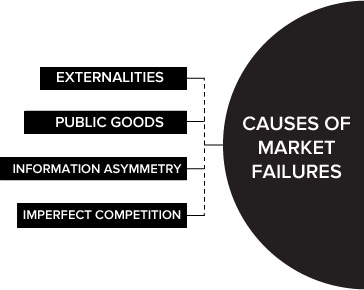What is Market Failure?
In economics, Market failure occurs when there is an imbalance in the quantity of a product demanded and supplied, which leads to an inefficient allocation of resources.
The success of the market is mainly dependent on the effective allocation of resources. However, there are situations when markets fail to allocate these resources efficiently, which is also known as market failure.

Table of Content [Show]
These failures can occur due to a variety of reasons, such as the existence of externalities, public goods and incomplete information. The occurrence of market failure is more likely to be in imperfect competition, due to existence of market power of organisations.
Thus, these organisations can influence the prices to increase their profits, resulting in total failure of markets.
Also Read: Elasticity of Demand
Market Failure Definition
Market failure can be defined as a situation where the quantity of a product demanded by consumers is not equal to the quantity supplied by suppliers. It occurs mainly due to inefficient allocation of goods and services in the free market.
In such a situation, the social costs incurred in the production of goods are not minimised, resulting in wastage of resources. Thus, the equilibrium between supply and demand of the product is not reached.
Market Failure Examples
Let us understand the concept of market failure with the help of an example.
It is known that wages are defined in accordance with the minimum wage laws. Therefore, wage rates are established at the going market-clearing wage to raise market wages. On this, critics argue that employers prefer to employ less minimum-wage employees at a higher wage cost. Consequently, more minimum-wage workers remain unemployed, thereby resulting in market failure due to high social costs.
Thus in simple words, market failure can be referred to as imperfections occurring in exchange of products and services between buyers and sellers; thereby preventing efficient allocation of scarce resources in the market. Market failures are corrected by governmental interventions only.
Also Read: Economies of scale and Diseconomies of Scale
Causes of Market Failures
Market failures are not attributed to a single factor. There are various causes that can result in market failures. However, there are four most important causes of market failures, as listed in Figure
Causes of Market Failures are discussed below:

Externalities
Externalities can be defined as an impact of production and consumption of products affecting the third-party (one who is neither a consumer nor the producer of the product). Externalities can be either positive or negative.
- Positive externality can be defined as the positive impact of the consumption of a product on the third-party.
For example, an increase in education of individuals can result in an increase in productivity, fall in unemployment and higher political participation in the country.
A positive externality is also known as an external benefit. - Negative externality can be defined as the negative impact of the consumption of a product on the third-party. In this case, the social cost of an activity exceeds the private cost.
Example of a negative externality is noise pollution due to various sources, which can be mentally and psychologically disruptive for nearby people.
Negative externalities are also known as an external cost.
It is to be noticed that both the above-mentioned externalities can result in market inefficiencies.
In the case of a positive externality, a producer does not like to invest in the activity unless the government aids him with a subsidy. Thus, there is underproduction of such goods.
On the other hand, in a negative externality, producers do not take into consideration the external costs and keep on manufacturing large quantities of goods. Thus, both these externalities require governmental regulations to prevent market failures.
Public goods
Public goods are goods that are characterised by non-excludability and non-rivalry.
- By non-excludability, it means that a good that benefits an individual can be used by others too to derive the same benefits.
- Non-rivalry implies that the enjoyment of using a product does not reduce the satisfaction of those who have been using it from a certain time.
An example of a public good is the defence system, as it provides protection to all the individuals of a nation. The problem with these goods is that they can be used by everyone after made available making it impossible to regain the costs of the provision by extracting payment from users resulting in market failures.
Information asymmetry
Information asymmetry deals with the study of decisions in transactions, wherein one party has access to more or better information than others. Due to the absence of the same information to all the participants, individuals or organisations are unable to make the right decisions. This results in an imbalance of power in transactions that can lead to market failure.
Due to information asymmetry, the following two problems occur:
- Adverse selection: This implies taking advantage of asymmetric information before the transaction.
For example, a person may be more eager to purchase life insurance due to health problems than, someone who is healthy. - Moral hazards: This implies taking advantage of asymmetric information after a transaction.
For example, if someone has car insurance he may commit theft by getting his car stolen to reap the benefits of the insurance.
Imperfect market conditions
Market failure is also caused due to imperfect market conditions, such as monopoly (existence of a single supplier in the market) and oligopoly (existence of few firms that control the market). In the imperfect market structure, organisations have the market power to influence prices. This can result in inefficiencies due to the following:
- Existing firms have the power to raise prices to increase their profits while the demand remains the same.
- Various barriers to entry by other firms restrict competition in the market.
- To prevent market failures due to the presence of market power, government interventions are required to correct the market operations or set prices at a competitive level.
Leave a Reply